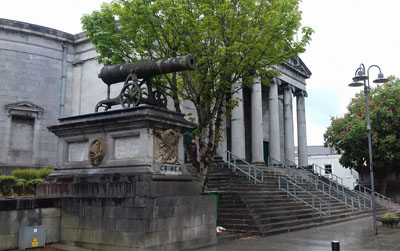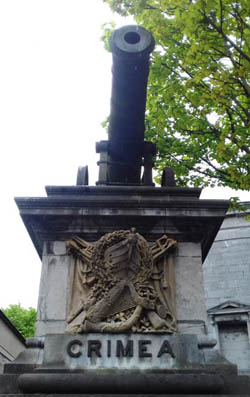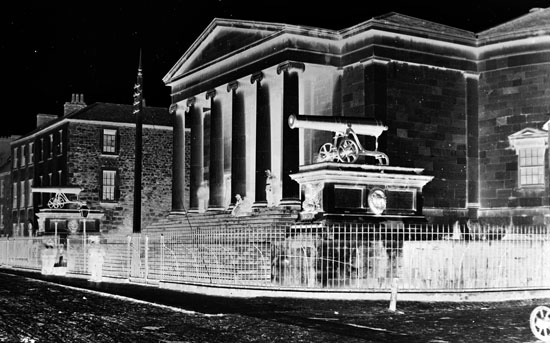|

 CRIMEAN CANNONS - WHERE ARE THEY NOW?
CRIMEAN CANNONS - WHERE ARE THEY NOW?
The Courthouse
Ashe Street
Cloonalour
Tralee
Kerry
Ireland
The Tralee Courthouse was designed by William Vitruvius Morrison and built in 1835. An austere building set above the street and acessed by a large flight of steps, the courthouse has a fine portico and pediment. It has monuments either side of the entrance steps, comprising two cannons on plinths. Unlike many similar monuments elsewhere, these have survived in their original locations since inception. The exterior remains largely as originally designed but the interior was reconstructed in the 1980s. Morrison`s name is inscribed on the architrave at the southern end of the portico.

The cannon memorials at the Tralee Courthouse commemorate the residents of Kerry who gave their lives in the Crimean War (1853-1856) and the wars in India and China. On each plinth of the memorial is a Russian cannon from the Crimean War. The pedestals for the guns were created by George Hallam. Decorated with sculptures and tablets of Mansfield stone they were considered an appropriate monument to those who served in the Wars. The trophy guns arrived in 1858 and were placed outside the courthouse where they created much controversy. They were not actually hoisted on to the pedestals until the building works were completed in 1861. Originally they were gold in colour, creating an impressive compliment to the light coloured stonework with its golden decoration and text panels.
The long term controversy over the Irish involvement in the affairs of England however led to an interesting discovery concerning the Crimean cannons. It was reported in 2011 that the
cannons were a timebomb that had existed for some 20 years. One was potentially a dangerous explosive until the Army defused it. People walking past the cannon were unaware of the five sticks of gelignite, a detonator and a fusewire hidden inside the barrel. The explosives had lain hidden there for about 20 years following an abortive attempt to destroy the cannons. Following a tip-off, an Army disposal team, with Garda back-up, moved in and removed the explosives, later destroying them. Apparently the gelignite could have exploded at any time; especially as the condition of it deteriorated over the years. The gelignite found in the cannons would be damp, making the situation more dangerous.
It is understood that people who became aware of the presence of the gelignite decided to notify the authorities for safety reasons.

Above - the courthouse circa 1900, before trees masked the impressive architecture.
In spite of renovation of the exterior from time to time and the past restructuring of the interior, the impressive courthouse is still under threat. In 2018 the Courts Service is due to make a decision on it's future. A formal assessment indicated that very little potential existed for developing the existing courthouse site to provide modern court facilities. The building has no press facilities, wheelchair access, or family law rooms. It also suffers from overcrowding. Summarising, the conclusion is that the building structure and the services within the building are generally in poor condition. Tralee could therefore soon be looking for a new use for this historic town centre building with its impressive cannon guarding the entrance.
ADDITIONAL INFORMATION

CONSTRAINTS
Open set times only
FACILITIES
Access all Year, Access by Road, Access on Foot
LANDSCAPE
City Centre
REGION
Ireland
THE FEATURES PRESENT
Crimean Cannon Location, past or present
|









